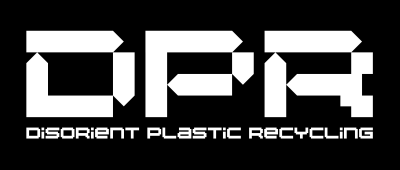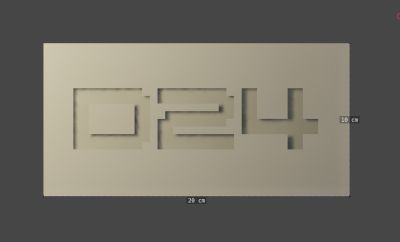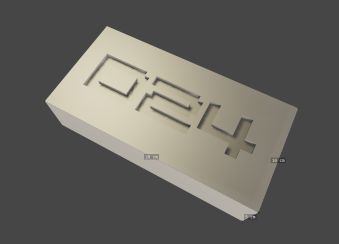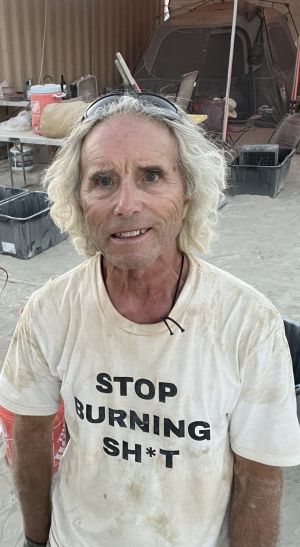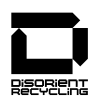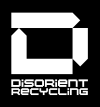Disorient Plastic Recycling
Disorient Plastic Recycling aka DPR (pronounced deeper)
Cell Lead: The Eye
The Disorient Plastic Recycling Lab
After decades of discussions, planning and good intents, we are still in what feels like the Stone Age of plastic recycling both on the macro (planetary) level where less than 10% of all plastic products are being recycled and the micro (Disorient) level.
We strive to eliminate our reliance on single-use plastics. A lasting solution demands that we break the table-to-landfill cycle and weave plastic recycling deep into our lives by turning it into a practice, a ritual. While we work on that, our goal is to recycle 100% of the plastic that we use at Disorient events. The Disorient Plastic Recycling Lab was created to help us understand the problem and design solutions for our camp's plastic recycling goal.
Our plan for Phase I
1. Keep it simple. Disorient is action-oriented. DOers learn by doing. We start with a simple process and refine our strategy as we learn from experience.
2. Use what's readily available. The chosen recycling process should not require water, chemicals, additives, adhesives, or fillers. Ultimately, it should not require electricity either but we will probably use some electricity at the beginning to jumpstart the process.
3. Minimal pre-processing, at least at the beginning. We need to find ways to make recycling entertaining and intellectually rewarding, in other words, we need to amplify its feel-good factor and make it viral. Starting a recycling practice should be as easy as possible with only minimal sorting, cleaning or pre-processing. There are arguments for pre-processing (more on this below) but at our stage of recycling (remember, we're in the Stone Age) we just need to keep it simple to get started. We can get fancy later.
4. On-site, on-scale and self-reliant. The transportation of discarded plastics accounts for a large part of plastic-related pollution. Ironically, current recycling strategies involve polluting the air further by shipping huge amounts of waste around the planet... to burn it there. Following our DIY ethos, plastic recycled by Disorient is not moved to another facility across the planet or even across the playa. It is reconfigured on site with a solution tailored to our goal.
5. Distributed. To have a better chance to reduce our contribution to the landfill, plastic recycling needs to become easy, hyper-local and sexy. Based on point #4 above, the solution should be open-source and easily replicable by other individuals/camps/communities. The current centralized industrial solutions need to be balanced and possibly replaced with decentralized individual solutions. We need to address the problem where it happens: in everyone's backyard. Small solutions distributed widely.
6. Start with Disorient. In recent years Disorient camp at Burning Man has welcomed north of 200 campers per year. Our plan is to design and implement a system that will be able to address the plastic recycling needs of all our campers.
Types of plastics
Pre-sorting before shredding requires being able to identify the different types of plastic. There are 7 main types of plastics to be considered for our recycling purpose.
To determine which type of plastic a container is made of, you should look for its Resin Identification Code (RIC), which is the number (between 1 and 7) within the triangular recycling symbol located on each plastic product. This plastic recycling code system was introduced by the Plastics Industry Trade Association (SPI) in 1988 to assist communities that were implementing recycling programs.
The argument for pre-sorting
During our chat at the Sun Contemporary gallery opening on 20240404 in Bali, Sam (founder of Sungai Watch with more than 2000 tons of plastic collected to date in Indonesia and counting) recommends separating plastics before compressing them. His argument is that once plastics are mixed, they are no longer recyclable. There are dozens of different types of plastic out there but 7 categories have been given recycling codes which makes sorting a less daunting task. Sam claims that plastic bags are the most common type of plastic waste in Bali. The different types of hard plastics are usually more difficult to identify.
Recycling codes
Resins are divided into 7 different identification codes.
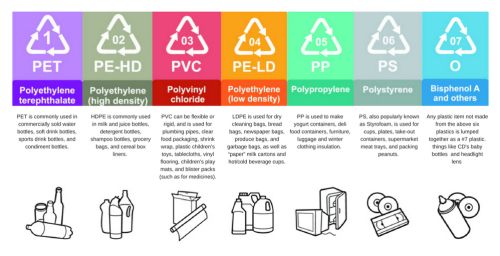
Shredding
The first step of the process is to break-down plastic objects to be recycled into little chips. For this, we need a shredder.
The shredding part of the process requires more investment since the shredder itself is a relatively expensive piece of equipment starting around 1,000 USD in Asia and around 2,000 USD in the US.
Our first Plastic Shredder
20240315: We have selected and purchased this shredder. DPR goes live at CCXii upstate NY at the end of May.
Early research on shredders
We use a plastic shredder like this one (Tokopedia, Indonesia) or that one (Amazon, USA) to turn mixed plastics into chips.
We plan to start with a shredder rather than a granulator. Granulator vs shredder: what is the difference?
Some US companies that provide industrial shredders (for reference only since we will start with a shredder smaller than the ones those companies provide): Lanrryy Machinery, Franklin Miller, Vecoplan
Example of plastic shredder at the Museum of Space Available, Bali, Indonesia, 2022:

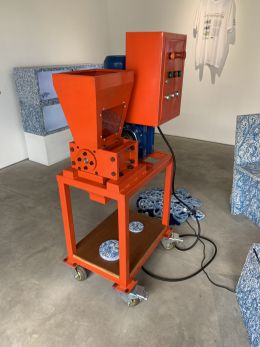
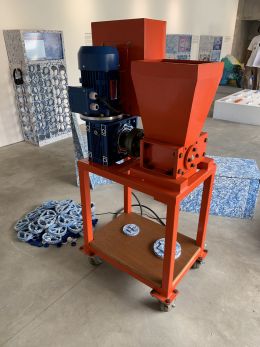
Compressing
We use a compressor similar to this one or that one with a mold to form the plastic chips into bricks following this example.
Compression can be achieved with a simple car jack. The compression mold is a relatively affordable one-time investment. Using a 2 ton press will work ok. A 10 ton press will probably give better result. What happens if we use a 4000 ton press to create our plastic bricks?
Pressure equals heat. Solar heat can be used to soften/melt the plastic chips to help the compressing process. For instance we could leverage the heat stored by a large metal object such as a shipping container exposed to the sun to melt the shreds of plastic into metal molds. In the desert, we could also explore solar ovens.
20240310: IceCream warns about poison released when melting plastic. Outgassing is a concern and needs to be researched. What kinds of gas are being emitted? How toxic are those gases? Do different resins emit different gases? Toxicity levels indoor versus outdoor? Is outgassing a concern at our relatively small scale? What measures should be put in place to avoid adverse health risks?
Our first brick
Recycled plastic brick
"D24" debossed on one side
Dimensions: 20cm x 10cm x 5cm
Brick Compressor
Examples of brick compressor and molds
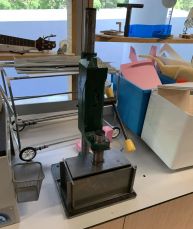
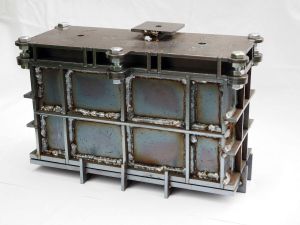
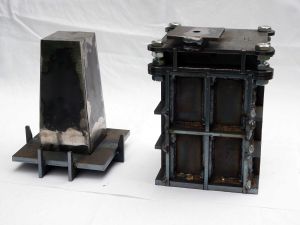
Human-powered recycling set
Example of human-powered plastic shredder and brick compressor at Monsieur Spoon in Pererenan, Bali, Indonesia, August 2020:
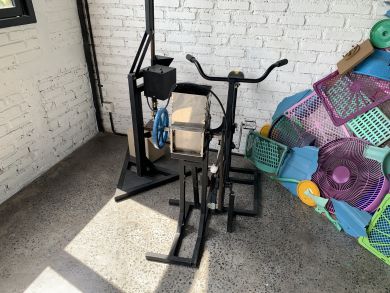

Although not our approach, here's a video of a radical experiment of melting mixed plastics together.
Which new plastic objects do we need?
Making objects out of plastic waste is neat but the question at the end of the recycling line is this: what kind of new plastic objects do we need? What objects are best positioned to gain the most from being made out of plastic? How do we avoid recycling the problem along with the plastic?
Disorient's goal is not only to become self-reliant when it comes to plastic recycling by recycling on-site (immediacy) but also to start using the resulting plastic bricks (and possibly other objects depending on the molds used during compression) as a component of our art installations. Creating 3D printing filaments is a possible solution but requires specific types of plastics which means that we would need to add pre-processing steps to our plastic recycling. This is something that we are trying to avoid at the beginning.
It's somewhat comforting to know that when our recycled plastic objects become obsolete, we can throw them back into the shredder for another cycle.
None of this is new. What's new is to actually make it happen locally.
Objects made with recycled plastic
Ombak Lounger. A chair by Merkaba Designs for Sungai Design
PLAEX bricks. Interlocable building system based on Lego-inspired building blocks fabricated in Canada with a mix of thermoplastic and waste construction aggregates. This new material called PLAEX-crete looks and feels like concrete.
“STOP BURNING SH*T” T-shirt
D22 camper and co-builder of the first Man at the first Burning Man event at San Franciscos's Baker Beach in 1986, Jerry James inspires a new wave of non-burnable art.
Banner
DPR banner goes here.
